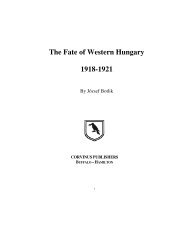The Tsangos of Romania - Corvinus Library - Hungarian History
The Tsangos of Romania - Corvinus Library - Hungarian History
The Tsangos of Romania - Corvinus Library - Hungarian History
Create successful ePaper yourself
Turn your PDF publications into a flip-book with our unique Google optimized e-Paper software.
Meanwhile, a vicious group <strong>of</strong> people were approachingCumania. <strong>The</strong>se were the Tartars. A great destruction followedthem whereever they went. <strong>The</strong> <strong>Hungarian</strong> sentry posts,villages, and the bishopric <strong>of</strong> Milko, were all destroyed. Thisevent is still remembered in one <strong>of</strong> the Csángó folksongs whichgoes: "szernyü hirtelenül minden elpusztula" meaning:everything was destroyed suddenly. In 1238, on behalf <strong>of</strong>4o,ooo Cumanians their leader Kötöny, asked for permission tosettle in Hungary. <strong>The</strong>y wanted to escape from the Tartars.<strong>The</strong>ywere granted land between the Danube and the Tisza,rivers, where they settled and where their descendants still live.After the danger caused by the Tartans was over, a newbishopric was founded in Szörénytornya for those <strong>Hungarian</strong>sand Cumanians who had stayed in the country.<strong>The</strong> 12th century, brought peace and along with it agrowth <strong>of</strong> the <strong>Hungarian</strong> population. New possibilities wereopen for these people in Szörénység where the number <strong>of</strong> thepeople was extermely low. Also on the land, which was leftempty by all those Cumanians who in 1239, emigrated toHungary, Vlachs from the Balkans settled down. <strong>The</strong>se werenomadic tribes, members <strong>of</strong> the Orthodox Church.
















